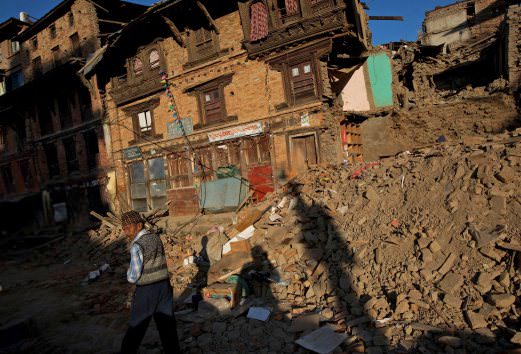KATHMANDU: US transport aircraft were to begin shuttling rescue teams and supplies today to remote areas of Nepal that are desperately awaiting aid, nine days after a devastating earthquake that killed more than 7,300 people.
The arrival late Sunday in Kathmandu of the United States Air Force C-17 aircraft and four tilt-rotor Ospreys gave another much-needed shot in the arm to the aid effort after a 101-year-old man was pulled alive from his ruined home.
An American general said pilots would begin flying sorties out of the capital Kathmandu to remote areas on Monday morning.
“They’re going to make an immediate difference,” US Brigadier General Paul Kennedy told reporters late Sunday.
“We’ve got search and rescue teams waiting to go out to the remote areas, we’ve got relief supplies, especially shelters.
“Most people don’t understand that a shelter is the most pressing need, so we’re going to take these things out starting tomorrow (Monday) morning,” Kennedy added.
“The hope is that the sorties start today,” an unnamed US embassy official confirmed to AFP today.
While the latest official death toll for Nepal stood at 7,250, with some 14,000 injured, authorities warned the final tally would be much higher. More than 100 people were also killed in neighbouring India and China.
A Nepalese official said the US aircraft would also airlift victims out of remote areas which experienced some of the worst devastation of the 7.8-magnitude quake on April 25.
“They are also assisting any casualties in mostly the eastern side of Nepal… places worst hit like Sindhupalchowk, Gorkha area,” Suraya Prasad Silwal, a spokesman for Nepal’s home ministry, told AFP.
Finance Minister Ram Sharan Mahat said the death toll was likely to jump once relief teams reached mountain villages flattened in the worst quake to hit the nation in more than 80 years.
“There are still villages where we know that all houses have been destroyed, but have not yet been able to reach,” Mahat said.
“The aftershocks have not receded and we expect the final casualty numbers to climb much higher,” the minister said, as he appealed for hundreds of millions of dollars in foreign donations to help rebuild the country.
Around two dozen countries have been helping in the relief effort. And while the international rescue teams have been welcomed by the Nepalese authorities, they have also created a logjam at the country’s only international airport on the outskirts of Kathmandu.
Authorities said on Sunday that the Tribhuvan International Airport has been closed to heavy planes over concern about the condition of the single runway after the quake and a series of strong aftershocks.
But although airport managers issued a notice saying that aircraft with a total weight exceeding 196 tonnes would not be allowed to land, it did not prevent the arrival of the giant US planes.
While no survivors have been found alive in the ruins of Kathmandu since Thursday, rescuers did pull a 101-year-old man alive from his ruined home in a rural district on Saturday, a week on from the disaster.
Funchu Tamang was rescued with only minor injuries to his ankle and hand in Nuwakot district, some 80 kilometres (50 miles) northwest of Kathmandu.
“He was brought to the district hospital in a helicopter. His condition is stable,” police officer Arun Kumar Singh told AFP.
Police also pulled three women survivors from under rubble on Sunday in Sindhupalchowk, one of the worst-hit districts, although it was not immediately clear how long they had been trapped.
Police have found more than 50 bodies, including those of six foreigners, in Nepal’s popular Langtang trekking region following last weekend’s devastating earthquake, a senior local official said Sunday.
Another 100 foreign tourists are still feared to be missing in the Langtang area north of Kathmandu.
Climbing firms Sunday called off their Everest spring expeditions, after the quake-triggered avalanche killed 18 on the world’s highest peak.
“With ongoing aftershocks and tremors we can’t continue expeditions,” said two-time Everest summiteer Dawa Steven Sherpa of Kathmandu-based Asian Trekkers.–AFP/nst







